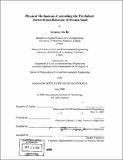Physical mechanisms controlling the pre-failure stress-strain behavior of frozen sand
Author(s)
Da Re, Gregory, 1970-
DownloadFull printable version (34.02Mb)
Other Contributors
Massachusetts Institute of Technology. Dept. of Civil and Environmental Engineering.
Advisor
Charles C. Ladd and John T. Germaine.
Terms of use
Metadata
Show full item recordAbstract
The physical mechanisms controlling the pre-failure stress-strain behavior of frozen sands are investigated in triaxial compression. The pre-failure, or small strain behavior (Ea<l%), is represented by the initial stiffness (Young's modulus) and the upper yield stress, a very distinctive yield point representing the onset of large unrecoverable plastic strains. An extensive experimental program was conducted on a number of ice-saturated particulate systems to investigate the dependency of these two parameters on volume fraction, stress level, strain rate, and temperature, as well as on particle size, stiffness, roughness, shape, and interfacial bond strength. Theories for composite material behavior are employed to analyze the observed stress-strain-time-temperature behavior. The stress-strain behavior has been measured in a high-pressure, low-temperature automated triaxial compression testing system. Strain was evaluated using a novel on-specimen measurement device capable of consistently resolving displacements of less than 0.1 microns, corresponding to strains of less than 0.0002% for specimens measuring 3.6 cm x 7.6 cm. Very precise temperature and strain rate control systems contributed to the reliability of the small strain measurements at confining pressures up to 10 MPa. Experimental findings show that the Young's modulus of frozen soils varies significantly with particle modulus and increases slightly with particle volume fraction, but does not change with strain rate and temperature. The development of stiffness, however, relies heavily on the extent of coupling between phases for the effective transfer of shear stress. This coupling can take the form of an adhesional bond or a frictional bond. In natural sand systems, shear stress is transferred through surface roughness and particle angularity and consequently the presence of an adhesional bond is not important. However, adhesional bonding is much more important in systems composed of smooth spherical particles. Application of reinforcement theories for two-phase particulate composites has led to a new approach for predicting the Young's modulus of frozen sand. The upper yield stress behavior is controlled primarily by strain rate, temperature, and particle grain size, and for fully-bonded materials, is essentially independent of particle volume fraction and stress level. In the absence of an adhesional bond, however, the degree of surface roughness and stress level affect the upper yield stress of the system, showing the importance of coupling in this region as well. The qualitative behavior of the upper yield stress relative to polycrystalline ice can be explained by examining the influence of ice-particle interaction on the nature of cracks propagating through the ice matrix.
Description
Thesis (Ph.D.)--Massachusetts Institute of Technology, Dept. of Civil and Environmental Engineering, 2000. Includes bibliographical references.
Date issued
2000Department
Massachusetts Institute of Technology. Department of Civil and Environmental EngineeringPublisher
Massachusetts Institute of Technology
Keywords
Civil and Environmental Engineering.